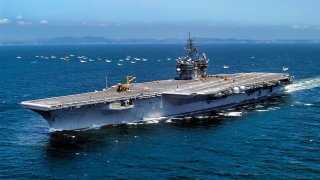The U.S. Navy's Kitty Hawk-Class Aircraft Carriers Were a Masterpiece
The Kitty Hawk-class aircraft carriers, consisting of Kitty Hawk, Constellation, and America, marked a notable evolution in naval aviation from the earlier Forrestal-class. Designed as a moderate upgrade, they featured better-placed elevators and a longer deck, enhancing operational efficiency and aircraft handling.
Summary: The Kitty Hawk-class aircraft carriers, consisting of Kitty Hawk, Constellation, and America, marked a notable evolution in naval aviation from the earlier Forrestal-class. Designed as a moderate upgrade, they featured better-placed elevators and a longer deck, enhancing operational efficiency and aircraft handling.
Launched between 1961 and 1965, these carriers were instrumental in modernizing carrier operations. The class saw extensive service, with substantial investments in upgrades during the 1980s. The America was notably sunk in a study to understand battle resilience.
The last of the class, Kitty Hawk, was decommissioned in 2009, concluding nearly five decades of service.
Exploring the Legacy of the Kitty Hawk-Class Aircraft Carriers
Most people don’t recognize the name Kitty Hawk as a class of aircraft carrier. While the names Ford, Nimitz, and Enterprise conjure thousand-foot vessels launching modern fighter jets, Kitty Hawk is a name associated most closely with the Wright Brothers and their dusty biplane.
But the Kitty Hawk was indeed a carrier class. It served admirably for half a century and provided an important benchmark in carrier progress.
Designing the Kitty Hawk-Class Aircraft Carriers
Some classes, like the Ford, are game-changers in carrier capabilities. The Kitty Hawk, however, was designed as more of a gradual improvement over the preceding Forrestal-class, which featured four boats – the Forrestal, Saratoga, Ranger, and Independence.
Built between 1952 and 1958, the Forrestals were the first class of supercarriers to feature deck-edge elevators, angled decks, and high tonnage. The Forrestals served until 1998 but had some very obvious drawbacks, namely their elevator placement. The elevators were situated in the launching and landing path of the waist catapults. Not ideal.
Recognizing the need to smooth a few of the Forrestal’s wrinkles, the Navy set about designing the Kitty Hawk. The carrier was not a direct replacement, but instead something like a supplement offering mild improvements.
The Kitty Hawk was longer than the Forrestal, with more intuitive elevator placements. Two of the elevators sat forward of the island and one after, with one elevator on the portside stern. This arrangement was indeed more functional, allowing jets to be launched and to land more easily, which of course improved the efficiency of the carrier’s flight operations and boosted the vessel’s sortie generation rate.
Building the Kitty Hawk
Only three Kitty Hawk carriers were built: the Kitty Hawk, Constellation, and America. A fourth Kitty Hawk was planned, and the boat was built. But the finished product departed so heavily from the Kitty Hawk design that the vessel, the John F. Kennedy, was designated as the only ship of a distinct class.
The John F. Kennedy was supposed to be nuclear-powered, but Congress refused authorization, so it was powered conventionally. The vessel is 17 feet shorter than the Kitty Hawk class, with a smokestack that tilts outboard to pump gas away from the flight deck. The Kennedy also featured an angled end waist, which differed from the Kitty Hawks but would be shared with the upcoming Nimitz-class carriers.
The Kitty Hawk class served for decades. In the late 1980s, the vessels were upgraded with a Service Life Extension Program (SLEP) that saw $785 million invested in the Kitty Hawk and $800 million in the Constellation. The Kennedy was not upgraded under the SLEP program, but it did ultimately receive $491 million-worth of upgrades to keep her afloat.
The America was sunk for the sake of studying her ability to take punishment under normal combat circumstances.
The last Kitty Hawk, the namesake vessel, retired from service in 2009.
About the Author: Harrison Kass
Harrison Kass is a defense and national security writer with over 1,000 total pieces on issues involving global affairs. An attorney, pilot, guitarist, and minor pro hockey player, Harrison joined the US Air Force as a Pilot Trainee but was medically discharged. Harrison holds a BA from Lake Forest College, a JD from the University of Oregon, and an MA from New York University. Harrison listens to Dokken.
Image Credit: Creative Commons.


